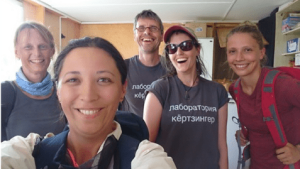A trip to the east corner of the world: Kolyma River, Northeast Siberia.
The Arctic is one of the world regions that is mostly affected by climate change. There, the rising of atmospheric temperatures since post-industrial times has increased more than twice than the rate of increase in the rest of the world, leading to irreversible consequences such as the reduction of sea-ice cover, or the melting of permafrost (frozen soil layers that have not melt in more than two consecutive years). This is the so-called “Arctic amplification”.
When permafrost melts, the unfrozen layers of soil lose their stability leading, for example, to sudden or gradual collapse of pieces of land (known as ground subsidence), as well as erosion of river banks. Northeast Siberia, is a region dominated by the presence of permafrost. In this region, the layers of permafrost have been frozen for the last 11,700 years (late Holocene), until now, that due to global warming, they are starting to melt. In addition, six big rivers feed each year the Arctic Ocean with vast amounts of freshwater, soils, nutrients, etc., especially after the long winter period
when snow and water bodies melt. During this process, more and more soil from permafrost is also transported to Arctic ecosystems, such as rivers. But what happens when the melted permafrost soil meets the modern environments? Interested on the consequences of this processes, as part of the project PROPERAQUA (DFG funded), we traveled to Northeast Siberia to investigate the Kolyma river, which is the easternmost and one of the major six Arctic rivers.

We were a team of five scientists: Prof. Arne Körtzinger and Anna Caning (pCO 2 and pCH 4 measurements), Prof. Kirsten Küsel (microbiology anlysis), and Sophie Arzberger and myself (dissolved oxygen and other biogeochemical properties). Our travel started from Germany on the 11 th June, 2019. We knew the trip will be long since we prepared for it many months in advance. Our research instruments had to be shipped also months ahead. Our destination was the city of Chersky (Sakha Republic),
located at 68 o 46’ N and 161 o 20’ E and at about 1,920 km east from Yakutsk (capital city of the republic) and about 150 Km south of the Arctic Ocean. Chersky is located 10 time zones more than Germany (10 hours more), which means that during our travel we did not experience darkness for nearly two days, and kept shifting our watch hours ahead. To reach Chersky, we traveled first from Jena to Frankfurt (Germany), starting our trip at 7 am from home.

We flew first to Moscow, then to Yakutsk and finally to Chersky, arriving on 13 th of June at 12 pm local time (2 am in the morning local German time).
The easternmost we traveled, the airplane and airports became every time smaller, but the landscape became every time more and more pristine. One of the most wonderful views from the airplane was at our arrival to Northeast Siberia, with intricate streams and tributaries attached to the Kolyma River, and the view of still frozen lakes.
Upon our arrival in the small airport of Chersky, we were warmly welcomed by our local collaborative partners: Nikita and Sergey Zimov from the Northeast Science Station (NESS) and Pleistocene Park.
The ice in the Kolyma river had fully broken down 13 days before and rapidly, huge amounts of freshwater traveled from upstream waters down to reach the Arctic Ocean, this period is known as the “freshet” and is evidenced by the rise in the river water level compared to summer levels and elevated water discharge (peak reached on 31 st May with 27,700 m 3 s -1 of water discharged; https://arcticgreatrivers.org/).

We were at a good moment to sample this river and investigate what is carried out during the short freshet period. Despite our tiredness, we
immediately unpacked our boxes and started the preparations for an exciting boat trip that started on 15 th of June and ended two days after.
We navigated and sampled a length of 120 km in the Kolyma river, (which is only 5.6% of the total length of this river) starting at the NESS near Chersky city and westward to a place called Duvanny Yar.


Duvanny Yar is a landmark in Kolyma river where a large portion of the riverbank has collapsed and permafrost is visibly exposed. I have been interested on the climate change topic since I started my career in science in the nineties, and although I am absolutely aware of evidences such as
the steadily rise on the long-term measurements of atmospheric CO 2
concentrations, I was never so close and experienced so vividly an evidence of global warming to our planet earth.
After two long exhausting days of sampling the Kolyma river, and
experience of no darkness and the attack of hungry gigantic mosquitoes,
we returned to our home, the NESS and continued our research in the
laboratories for the next three weeks. We returned to Germany at the end of June where we continue analyzing our results and eager to learn what Kolyma river has unraveled to us.